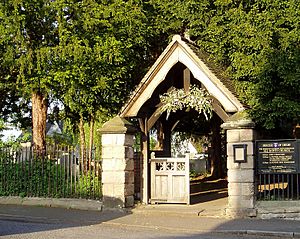All Saints' Church, Ockbrook facts for kids
Quick facts for kids All Saints' Church, Ockbrook |
|
|---|---|

Lych Gate
|
|
| 52°55′02″N 1°22′16″W / 52.91716°N 1.37123°W | |
| Country | United Kingdom |
| Denomination | Church of England |
| Churchmanship | Broad Church |
| Website | www.allsaints.ockbrook.com |
| History | |
| Dedication | All Saints |
| Architecture | |
| Heritage designation | Grade II* listed building |
| Architectural type | Gothic |
| Administration | |
| Parish | Ockbrook and Borrowash |
| Diocese | Diocese of Derby |
| Province | Canterbury |
All Saints' Church, Ockbrook, is a special church in Ockbrook, Derbyshire, England. It belongs to the Church of England.
Contents
History of All Saints' Church
Before the English Reformation, Ockbrook was a small church area (called a chapelry). It was part of the larger Elvaston parish. A priest called a curate looked after it. Money for the church (called tithes) went to the monks at Shelford Priory.
Changes Over Time
When monasteries were closed down, the Stanhope family moved to Elvaston. They became the main supporters of the church. In the mid-1500s, Ockbrook became its own parish.
The oldest part of the church is its tower. It was built in the 1100s and has very thick walls, about 4 feet wide. The church also has a very old font (a basin for baptisms). It is from the Norman period. This font was found and put back in the church in 1963. It had been outside in the vicarage garden for 150 years!
The wooden screen in the chancel (the area around the altar) was made in 1520. It was moved to All Saints' Church in 1810. This happened after the chancel was rebuilt. The choir stalls (seats for the choir) were also put in at this time. They might have come from the same place.
The Pares family from Hopwell became the church's supporters in the late 1700s. They still support the church today.
The church building has been changed and made bigger many times. This is why it looks the way it does now. Thomas Pares rebuilt the chancel in 1803. He also added a special burial place for his family, called the Pares vault. The north aisle (a side part of the church) was built in 1814. The south aisle was added in 1835. This cost about £700 at the time. A gallery (a raised seating area) was also added at the west end. In the 1890s, new wooden pews replaced the old box pews. The tower was repaired in 1890 and again in 1927.
Church Community
All Saints' Church is part of a combined church area. It works together with St Stephen's Church, Borrowash.
Special Memorials and Stained Glass
Inside the church, you can find several memorials. Many of these are for the Pares family of Hopwell Hall. Some of these memorials were made by a famous artist named Sir Richard Westmacott. He made memorials in 1805, 1823 (for Mary Pares), and 1824 (for Thomas Pares).
Memorials Inside the Church
- Chancel: Two brass memorials from the late 1800s are on the walls.
- South Aisle:
* A brass memorial for Thomas Sneap. * A white marble memorial for soldiers who died in war. * A Gothic-style memorial from around 1852 for Samuel Hey.
- Nave: (the main part of the church)
* A marble memorial for Henry Swindell, who died in 1801. It has a tall, pointed top and a carved picture of him. * A memorial made of slate and marble for John Winterton, who died in 1906. * Two brass plaques from the early 1900s.
Beautiful Stained Glass Windows
- The large window at the east end of the chancel has stained glass from 1968. It was made by Edward Payne.
- The north chancel window has stained glass from around 1927. It was made by Heaton, Butler and Bayne of Nottingham.
- The south chancel window has stained glass from the late 1800s.
- Two windows in the east part of the south aisle have stained glass. One is from around 1885 and is for Harriette Towle. The other is from around 1900. Both have brass plaques below them.
- The middle window on the north side has a brass plaque. It says Joseph Birkinshaw gave it in 1931. The eastern north window has stained glass from around 1898.
Churchyard and Organ
The churchyard is the area around the church. It has graves of five soldiers from World War I. It also has the grave of a Royal Air Force officer from World War II. These are called war graves.
The Church Organ
The Pares family had a special burial vault built in 1803. In 1928, Joseph Birkinshaw changed this vault into a space for the church organ. A brass plaque near the organ tells this story.
The church might have had an organ installed when it was rebuilt in 1835. Work on the organ was done in the 1900s by J.H. Adkins. Henry Groves of Nottingham also worked on it in 1960 and 1998. You can find more details about the organ on the National Pipe Organ Register website.
Past Organists
- Miss Chevin (around 1879 to 1890)
- Mr. W. Cotten (around 1896)
- E.S. Morris (around 1901)
- W.J. Baker (1903 - unknown end date)
- Albert Edward Mitchell (1906 - 1938)
- H. Garratt (around 1945)
More Information
- Grade II* listed buildings in Erewash
- Listed buildings in Ockbrook and Borrowash


